The AMD Ryzen 5 2500X and Ryzen 3 2300X CPU Review
by Ian Cutress on February 11, 2019 11:45 AM ESTCPU Performance: Rendering Tests
Rendering is often a key target for processor workloads, lending itself to a professional environment. It comes in different formats as well, from 3D rendering through rasterization, such as games, or by ray tracing, and invokes the ability of the software to manage meshes, textures, collisions, aliasing, physics (in animations), and discarding unnecessary work. Most renderers offer CPU code paths, while a few use GPUs and select environments use FPGAs or dedicated ASICs. For big studios however, CPUs are still the hardware of choice.
All of our benchmark results can also be found in our benchmark engine, Bench.
Corona 1.3: Performance Render
An advanced performance based renderer for software such as 3ds Max and Cinema 4D, the Corona benchmark renders a generated scene as a standard under its 1.3 software version. Normally the GUI implementation of the benchmark shows the scene being built, and allows the user to upload the result as a ‘time to complete’.
We got in contact with the developer who gave us a command line version of the benchmark that does a direct output of results. Rather than reporting time, we report the average number of rays per second across six runs, as the performance scaling of a result per unit time is typically visually easier to understand.
The Corona benchmark website can be found at https://corona-renderer.com/benchmark
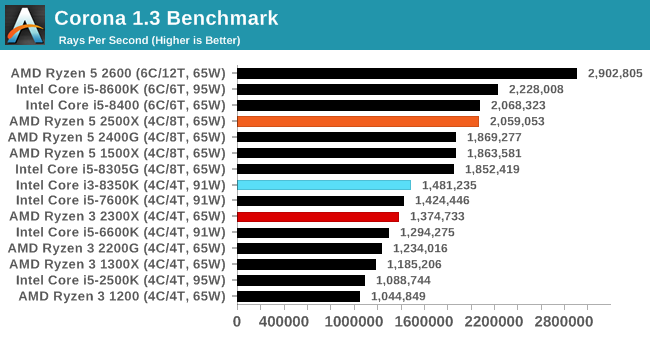
A raw multithreaded test, the eight thread CPUs here score above the quad cores without SMT. The 2500X with four cores and eight threads is on par with a six-core Intel CPU here.
Blender 2.79b: 3D Creation Suite
A high profile rendering tool, Blender is open-source allowing for massive amounts of configurability, and is used by a number of high-profile animation studios worldwide. The organization recently released a Blender benchmark package, a couple of weeks after we had narrowed our Blender test for our new suite, however their test can take over an hour. For our results, we run one of the sub-tests in that suite through the command line - a standard ‘bmw27’ scene in CPU only mode, and measure the time to complete the render.
Blender can be downloaded at https://www.blender.org/download/
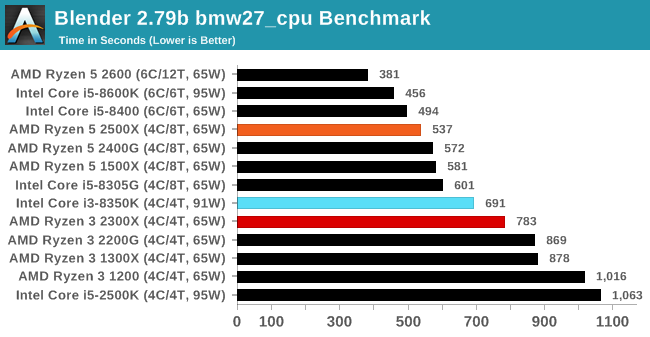
Bender is a variable threaded test, tackling lots of parts of the system. The move from a 4C/4T AMD chip to the 4C/8T AMD chip gets a good speedup, with the jump up in threads really helping. Our results are very clearly delineated on core count then thread count.
LuxMark v3.1: LuxRender via Different Code Paths
As stated at the top, there are many different ways to process rendering data: CPU, GPU, Accelerator, and others. On top of that, there are many frameworks and APIs in which to program, depending on how the software will be used. LuxMark, a benchmark developed using the LuxRender engine, offers several different scenes and APIs.
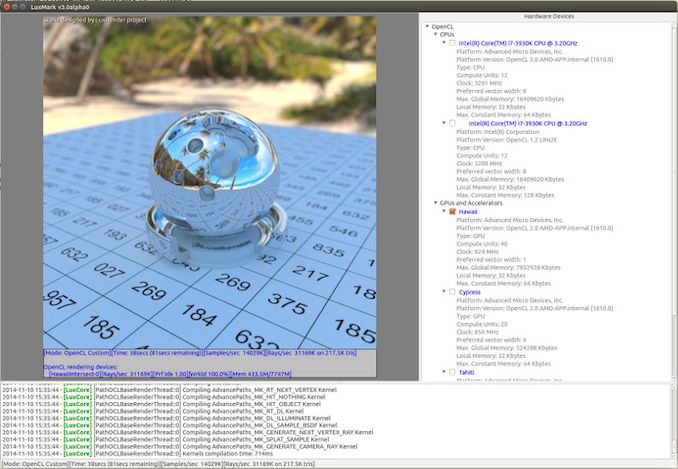
Taken from the Linux Version of LuxMark
In our test, we run the simple ‘Ball’ scene on both the C++ and OpenCL code paths, but in CPU mode. This scene starts with a rough render and slowly improves the quality over two minutes, giving a final result in what is essentially an average ‘kilorays per second’.
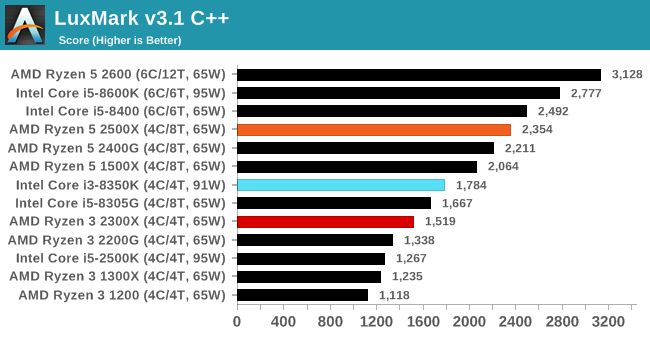
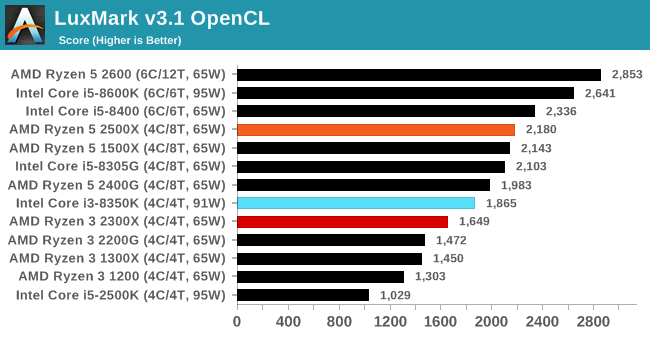
POV-Ray 3.7.1: Ray Tracing
The Persistence of Vision ray tracing engine is another well-known benchmarking tool, which was in a state of relative hibernation until AMD released its Zen processors, to which suddenly both Intel and AMD were submitting code to the main branch of the open source project. For our test, we use the built-in benchmark for all-cores, called from the command line.
POV-Ray can be downloaded from http://www.povray.org/
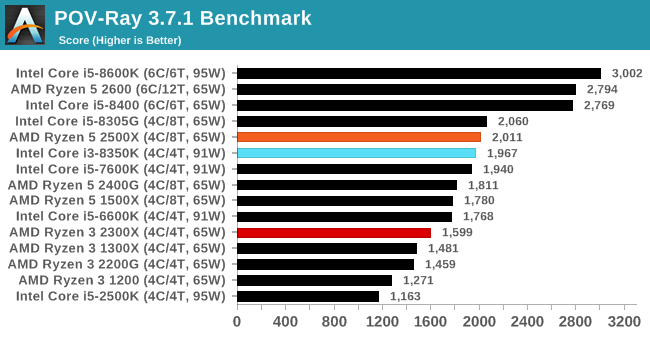
For POV-Ray, the better AVX2 performance of the Core i3 shows as it almost matches the 2500X.











65 Comments
View All Comments
Korguz - Monday, February 11, 2019 - link
Phynazbetter then the typical Intel.. overpriced, and not much gained
MDD1963 - Monday, February 11, 2019 - link
How many folks with GTX1080s would be using either of these CPUs tested (even if they were for sale)? :)Allan_Hundeboll - Tuesday, February 12, 2019 - link
Gamers on a budgetmikato - Thursday, April 4, 2019 - link
Someone that decided to start gaming, or changed to a game that required more graphics power so bought a graphics card. Maybe a kid whose parents bought a computer, or a hand-me-down computer. Even I have been gaming and building computers a long time and I have upgraded the graphics card on my computers several times around the middle of that system's lifetime (I keep them pretty long). I have friends that play WoW and needed to upgrade.There are plenty of situations.Have you seen gaming benchmarks with low end CPUs vs high end CPUs when both have the same high end graphics card?
Ethnipod - Monday, February 11, 2019 - link
wrong power consumption test ...Ryzen 5 2500X get DDR4 2933 (1.3 V) vs coffe lake DDR4 2667 (1.2 V).
(for Ryzen 5 2500X clock up ram freq to 3200, or downclock to 2667)
ty and sorry for my eng.
pajuk - Monday, February 11, 2019 - link
another intel biased review . Why didint youput the price of the i5-8600k like in other reviews??maybe because you know that it costs the same as amd 2700 ??? tired of LIARS.
Korguz - Monday, February 11, 2019 - link
prove it.. post some links...Irata - Tuesday, February 12, 2019 - link
The statement by Pajuk is actually not correct - the i5-8600k costs $288.96 boxed, the Ryzen 7 2700 229.99 - both at Newegg - so it's not the same price but $60 more.pajuk - Tuesday, February 12, 2019 - link
https://www.pcdiga.com/processador-amd-ryzen-7-270...https://www.pcdiga.com/processador-intel-core-i5-8...
pajuk - Tuesday, February 12, 2019 - link
you help me even more, this LIARS in anadtech are as bad as tomshardware.